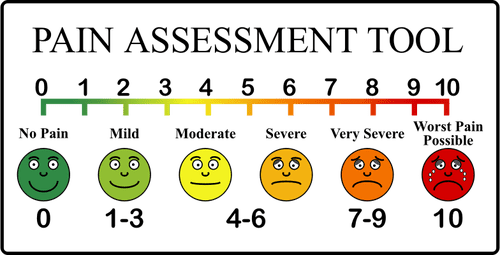
We are not ourselves when we’re experiencing pain. It’s important for medical professionals to understand what you mean when you try to describe your pain, although it doesn’t always translate easily into words. Not having the pain you experience fully understood, especially if you’re suffering from chronic pain, could mean waiting for it to be investigated, treated and taken seriously.
Communicating your pain with medical professionals can be challenging, but we’ve got some helpful avenues of communication for you to explore that we hope will help to make conversations surrounding pain a bit easier to approach.
Pain Scale Categories
There are multiple ways you could communicate your pain to your doctor. Because pain is relative and will vary person to person, using a scale to communicate pain levels is a simple way for medical professionals to understand what you’re experiencing.
VAS Pain Scale
Visual analogue scales (VAS) ask a patient to mark a place on a scale that accurately describes the pain they’re in. The Wong-Baker Faces Pain Scale, which was first developed for children, shows varying facial expressions so you can rate your pain based on the face that you most relate to. This particular pain scale also includes numbers to give you another way of describing your pain.
NRS Pain Scale
Numerical Rating Scales (NRS) are another common way to communicate your pain with your doctor. You can verbally account for your pain by placing yourself anywhere from zero to 10 on the scale, zero being no pain and 10 being the worst pain.

Categorical Pain Scale
Categorical pain scales are the most thorough for communicating your pain. Their primary tool is words, but they also include charts, numbers, colors, and pictures to help you and your physician pinpoint exactly how you’re feeling. The McGill Pain Questionnaire, for example, shows pictures of the body so that you can effortlessly show where you’re feeling pain.
It also offers a variety of words that may describe your type of pain, including burning, tugging, stabbing and radiating. Based on all of the words that you choose you’re assigned a number, the highest being 78.
Alternative Pain Scales: Other Ways to Communicate Pain
Everyone experiences pain differently, because we each have our own pain tolerance.
- For your doctor to better understand what you mean by a ‘five’ on the NRS, you may want to let them know the worst pain you’ve experienced and describe how the pain you’re currently feeling relates to that.
- Track your pain by keeping a symptom log. Journalling what you’re feeling and when can help your doctor understand how your pain affects your quality of life.
- Using descriptive words such as ‘hot’ or ‘nauseating’ can help your care physician identify the cause of your pain and how to better treat it. Learn about the words for pain in your language and use the ones that resonate most with you.
- When medical professionals understand how pain impacts your daily life, they tend to take the pain more seriously. Do you have to make tradeoffs during the day to make sure that you have enough energy to get through it? Can you play with your children, and drive to work? Is it painful to do the laundry or take a shower?

By answering these questions, the medical professionals in our lives can come to a better understanding of just how seriously the pain we experience impacts our self-care and quality of life.
How have you effectively communicated your pain with the medical professionals in your life? We want to know! Share your story with us, and let us know if you have any tips on how to communicate pain with others.



